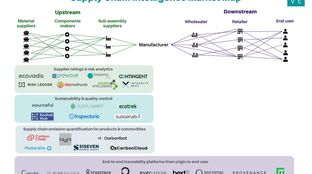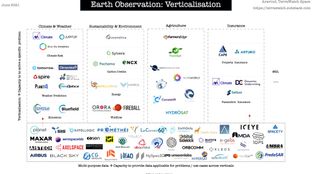
The missing link to net zero
Closing the loop on decarbonized & resilient supply chains with Energy Impact Partners' Nina Litman
With a hotter and drier future, climate experts warn that we must drastically rethink our approach to wildfire management. We’ve broken down below the areas in which innovation is addressing wildfires.

Wildfires are scorching the West. Every year continues to set a new record for the worst fire season. In 2020, with months still left, over 5 million acres have burned in California, Oregon, and Washington – wreaking havoc on communities, burning down homes, and releasing toxic emissions into the air. From a greenhouse gas perspective, the 2017-2018 California fires produced carbon emissions equivalent to running 15-20 coal plants at full capacity for a year. According to Matt Botill, the Chief Investment Officer at California Air Resources Board (CARB), “California’s forests cover about 1/3 of the State. Approximately 85% of terrestrial carbon is stored in forests and shrublands.” In other words, we’re locked in a terrible feedback loop where climate-exacerbated wildfires beget more CO2 emissions.
We’ve dragged our feet on climate action for too long and are now facing the fiery consequences. With a hotter and drier future, climate experts warn that we must drastically rethink our approach to wildfire management. We’ve broken down below the areas in which innovation is addressing wildfires.
Aging grid infrastructure and poor vegetation management are responsible for ~77% of wildfires. Utilities play an endless game of whack-a-mole managing vegetation around their lines; despite battalions of electric engineers, only a small squad of arborists are qualified to treat vegetation. These arborists are tasked with identifying hazardous areas and deciding which trees to cut – a manual process takes years to complete over millions of acres. Fortunately, startups like Overstory are working with utilities to leverage AI and satellite data to better manage vegetation. According to Indra den Bakker, CEO of Overstory:
With our technology, we’re able to do that same monitoring in one day – a massive increase in site revisitry. By providing more detailed information, we help our customers do more targeted vegetation management and help them understand current and future risks.
For when vegetation management isn’t enough, San Diego Gas & Electric (SDG&E) uses synchrophasors for near-instantaneous transmission line monitoring. By sending power and voltage stability metrics up to 60 times a second, synchrophasors unlock the potential for SDG&E to de-energize failing lines before they hit the ground and spark fires.
Although it sounds counterintuitive, organizations such as the California Air Resources Board and the California Department of Forestry and Fire Protection (CAL FIRE) also prevent wildfires through prescribed burning. Controlled fires reduce excessive amounts of brush, shrubs, and trees which lead to more catastrophic wildfires.
Innovators: Buzz solutions (AI for grid inspections), eSmart (drone-based infrastructure inspections), Linevision (overhead line monitoring), Overstory (vegetation intelligence)
As crews in California mobilize to battle further fires, first responders are deployed to destinations up and down the coast subject to reactive fire sightings. While utilities have in-house fire modelers who can forecast years ahead, game-time predictions prove to be difficult as high winds spread fires faster than models can solve.
Companies have deployed data- and imagery-driven tools to help firefighters do their jobs more efficiently. Microsoft partnered with the Department of Energy on AI tools to provide real-time information to first responders. Planet Labs and Salo Sciences released a tool called California Forest Observatory to create a detailed view of the state’s forest. Startups like One Concern and Terrafuse use predictive platforms to model how fires might spread as they are burning. According to Joe Paluska, CMO of One Concern:
One Concern’s beta solution leverages a constant stream of data from a variety of satellite sources, dynamic weather data, updated vegetation characteristics and fuel maps, and high-resolution topographic data, as well as on the ground information provided by sensors, firefighters and incident commanders to provide real-time situational awareness.
In regions most likely to be affected by power shutoffs, utilities implement Resilience Zones, temporary microgrids for essential services like hospitals and grocery stores. Companies like Switched Source are also trying to provide utilities with increased resiliency during emergency events by giving their systems more flexibility to redirect power flow.
Innovators: Clevest (mobile workforce deployment), Descartes Labs (geospatial data platform to detect wildfires), ISeeChange (community weather and climate sightings), LaderaTech (fire retardant to stop fires before they start), One Concern (climate resiliency software), OroraTech (wildfire detection and monitoring from space), Rain.aero (automated drones to shut down wildfires), Switched Source (grid power flow technology), ZoneHaven (tools for wildfire emergency response)
After the fires stop raging, homeowners and communities struggle for years to rebuild their homes and livelihoods. Companies like Homebound specialize in the start-to-finish wildfire rebuilding process. Nikki Pechet, the CEO of Homebound explains:
In October of 2017, over 6,000 homes burned down in Northern California. In the aftermath, homeowners felt helpless trying to navigate the maze of insurance, architects, permits and contractors. Our founding team witnessed this firsthand, having lost our own homes, schools and communities, and as we looked ahead at the rebuild process, we simply knew there had to be a better way. Homebound incorporates technology and a customer-first approach to simplify the rebuilding process and alleviate the stress, complexity and uncertainty that homeowners face after a natural disaster.
Beyond construction, Homebound helps homeowners navigate insurance policies, permitting, and financing. In the rebuilding process, the company helps replace fire-vulnerable homes (many built before 1960) with homes that include more resilient materials and defensible space that follow California’s most conservative and up-to-date building codes.
Innovators: Boxabl (fire-resistant modular homes), DroneSeed (using drones to replant trees), Mighty Buildings (3D printed houses), Woodoo (upgrading the performance of wood), Yuhu Builders (steel frame homes)
Interested in diving deeper? Check out our full interviews with Indra from Overstory and Matt from CARB.
Interested in more content like this? Subscribe to our weekly newsletter on Climate Tech below!

Closing the loop on decarbonized & resilient supply chains with Energy Impact Partners' Nina Litman

The new business of seeing climate from space

How supply chain traceability leads us to Net Zero